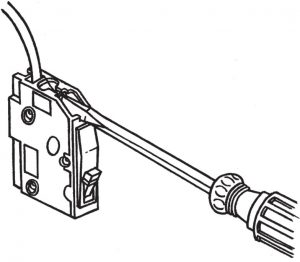Sizing the Heating Circuit
| AMPS | VOLTS | WATTS | CIRCUIT PROTECTION (CIRCUIT BREAKER SIZE) | 90C WIRE SIZE COPPER (NEW CONSTRUCTION) | 75C WIRE SIZE COPPER (OLD CONSTRUCTION) | WIRE SIZE ALUMINUM (OLD CONSTRUCTION) |
|---|---|---|---|---|---|---|
| 12 | 120 | 1,440 | 15 Amp - 1-Pole | #14/2 | #14/2 | #12/2 |
| 16 | 120 | 1,920 | 20 Amp - 1-Pole | #14/2 | #14/2 | #10/2 |
| 12 | 240 | 2,880 | 15 Amp - 2-Pole | #14/2 | #14/2 | #12/2 |
| 16 | 240 | 3,840 | 20 Amp - 2-Pole | #14/2 | #14/2 | #10/2 |
| 24 | 240 | 5,760 | 30 Amp - 2-Pole | #12/2 | #10/2 | #8/2 |
| 32 | 240 | 7,680 | 40 Amp - 2-Pole | #10/2 | #8/2 | #6/2 |
| 41 | 240 | 10,000 | 60 Amp - 2-Pole | #6/2 | #6/2 | #3/2 |
| 52 | 240 | 12,500 | 70 Amp - 2-Pole | #6/2 | #4/2 | #2/2 |
| 62.5 | 240 | 15,000 | 80 Amp - 2-Pole | #4/2 | #4/2 | #1/2 |
- The above circuit sizing is based on 90C copper wire and for reference only. 90C rated copper wire is the new standard, dou may have 60C copper wire or aluminum wire in an older installation, which will reduce the amount of capacity it is able to carry. Verify your insulation temperature rating. Always consult local codes for proper sizing.
- According to the National Electrical Code (NEC) electric heaters are considered a “continuous load”.
- The National Electrical Code (NEC) requires circuit breakers to be sized at 125% of the intended “continuous load”, ensuring sufficient safety margin when a device draws high power.
- To size a circuit breaker for a heater, you should select a breaker that is rated at 125% of the heater’s rated amperage , which means choosing a breaker that is 25% larger than the calculated amperage draw of the heater.
- According to the National Electric Code heating circuits are considered a continuous load and it is recommended to only use around 80% of the breaker’s capacity for continuous loads. (For example: a 20 Amp heating circuit cannot have more than 16 Amps of load connected.)
- 120 Volt heaters require 1-Pole circuit breakers; 240 Volt heaters need 2-Pole breakers.
- Use 2-wire cable with ground (Romex™ or BX).
- When placing multiple heaters on a circuit do not exceed the wattage listed for the corresponding wire and circuit breaker size. (For example: 2-1000W & 1-1500W, 240V heaters = 3500 Watts total. These 3 heaters would require 14/2 wire and a 20 Amp 2-Pole breaker if they were to all be placed on the same circuit. If more heaters are needed either run a new circuit or increase the wire and breaker size to accommodate the load.)
- A 1500 Watt heater will cost the same to run whether it is 120 or 240 Volt. 240 Volt heating circuits are more common because it reduces the Amp draw on your breaker/fuse panel, as the chart shows, you can place more heaters on a 20 Amp 240 Volt circuit (maximum of 3840 Watts) versus a 120 Volt circuit (maximum of 1920 Watts).
- 120 and 240 Volt heaters are not interchangeable. A 240 Volt heater run at 120 Volt will produce 25% of the rated wattage. A 120 Volt heater run at 240 Volt will be 4x 120 Volt rated wattage, destroying the heater which possesses a severe fire hazard.
- What voltage are my heaters? See Figures 1& 2.
Figure 1: One breaker indicates 120 Volt is feeding your heater.

Figure 2: Double breaker indicates a 240 Volt circuit feeding your heater.

Helpful Hints
Fan Heater or Baseboard?
Space: A baseboard heater takes up more wall space than a fan-forced heater which can cause problems placing furniture. (For example: a 2250 Watt Pic-A-Watt® heater will provide as much heat as a 9 foot baseboard.)
Comfort: A fan-forced heater will heat a room within a few minutes whereas a baseboard will require 30 to 40 minutes. A fan-forced heater will also maintain a more even temperature because the fan will circulate air around the room. This reduces the severity of hot/cold temperature swings.
Noise: A baseboard heater has no moving parts and therefore is quieter than a fan heater. The small Pic-A-Watt® heater uses a squirrel cage blower which makes it almost inaudible.
Efficiency: A 1500 Watt baseboard uses the same amount of electrical power as a 1500 Watt fan heater. The difference is a fan heater gives more even heat throughout the room thereby reducing air stratification (hot air rising and not mixing with the cooler floor air). This process makes you feel cooler causing you to turn the baseboard thermostat to a higher temperature setting whereby it runs more often thus using more electric power than the same size fan heater. Every 1° a thermostat is turned up will raise a power bill 3.1%. As such, a baseboard set to 75°F will cost you 15.5% more than a fan heater set to 70°F.
Which Fan Heater to Choose?
Use: If the heater will run often and be used as primary heating for the home King recommends using heaters with steel elements such as the Pic-A-Watt®. These elements carry a five year warranty and will hold up to the rigors of everyday use. For supplemental or occasional use open-coil elements work fine. If budgetary constraints are of primary importance open-coil heaters are the least expensive.
Noise: A propeller-type fan will make more noise than a squirrel cage fan. Open-coil elements make more noise than steel mass elements (Pic-A-Watt® ) due to the rate of heat exchange with the air. For large rooms, two small heaters will be quieter than one large heater.